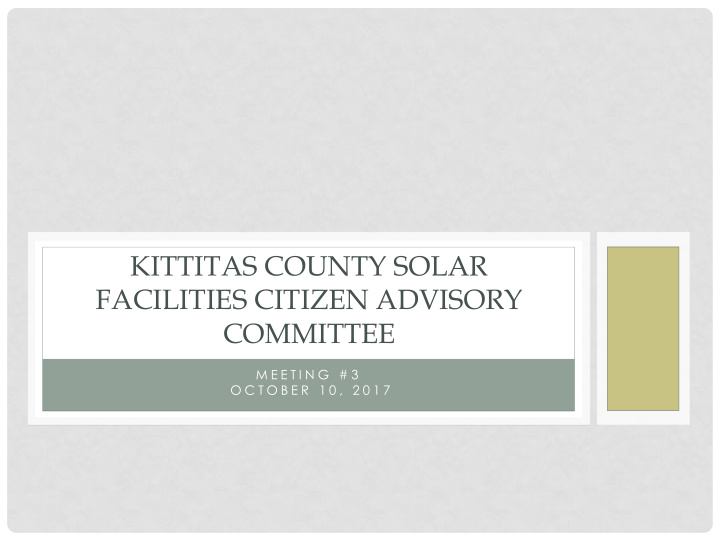



KITTITAS COUNTY SOLAR FACILITIES CITIZEN ADVISORY COMMITTEE M E E T I N G # 3 O C T O B E R 1 0 , 2 0 1 7
AGENDA 1. Review Minutes from Meeting 2 (5 minutes) 2. Committee Ground Rules (10 minutes) 3. Review Comment Matrix (10 minutes) 4. Discussion/Decision: Utility-Scale vs. Distributed Generation Facilities (10 minutes) 5. Discussion/Decision: Siting Criteria Mapping Alternatives (1 hour) 6. Break (10 minutes) 7. Discussion/Decision: Mitigation Measures Alternatives (1 hour) 8. Public Comments (10 minutes) 9. Next Steps (5 Minutes)
COMMITTEE GROUND RULES Meetings will begin and end on time. • Meeting Preparation: Committee members will receive meeting agendas and the • materials that will be discussed in advance of each meeting whenever possible. Members are responsible for reviewing these materials prior to the meeting, and for coming prepared for substantive discussions. Everyone’s opinion is important. We want to hear from everyone equally. Please do not • monopolize the conversation or just sit back quietly and listen. Stick to the agenda. It will be tempting to discuss issues other than those that are within • the scope of committee work. Please save these conversations for later. Don’t be afraid to ask questions. • Be courteous and polite. Please don’t interrupt others and limit side conversations. • Our goal is general consensus. Please come to each meeting with an open mind and • be prepared to work towards agreement. When consensus cannot be reached, decisions will be made by a majority of the voting members of the committee who are present. The vote and related discussions will be included in the record that goes forward to the Planning Commission and Board of County Commissioners.
COMMENT MATRIX
UTILITY-SCALE VS. DISTRIBUTED GENERATION • Up to 20 MW (Existing substation) vs. Greater than 20 MW (New substation)
THREE QUESTIONS FROM MEETING #1 1. Should solar facilities be allowed in Kittitas County? 2. Where should they go? 3. What regulations to mitigate impacts?
ZONING
ZONING
OVERLAY ZONE
ZONING PURPOSE STATEMENTS Commercial Agriculture Zone Purpose and Intent The commercial agriculture zone is an area wherein farming and ranching are the priority. The intent of this zoning classification is to preserve fertile farmland from encroachment by nonagricultural land uses and protect the rights and traditions of those engaged in agriculture. (KCC 17.31.010) A-20 Agriculture Zone Purpose and Intent. The agriculture (A-20) zone is an area wherein farming, ranching and rural life styles are dominant characteristics. The intent of this zoning classification is to preserve fertile farmland from encroachment by nonagricultural land uses; and protect the rights and traditions of those engaged in agriculture. (KCC 17.29.010)
Commercial Agriculture
Tier 1: < 5% Slope, Within 3 Miles of PSE Substation or BPA Right-of-Way Tier 2: < 5% Slope, Within 3 Miles of PSE Substation or BPA Right-of-Way and Within Agriculture 20 Zone Tier 3: < 5% Slope, Within 3 Miles of PSE Substation or BPA Right-of-Way and Within Commercial Agriculture Zone
ZONING PURPOSE STATEMENTS A-5 Agricultural Zone Purpose and Intent The purpose and intent of the agriculture (A-5) zone is to provide for an area where various agricultural activities and low density residential developments co-exist compatibly. A-5 zones are predominately agricultural- oriented lands and it is not the intent of this section to impose further restrictions on continued agricultural activities therein. (KCC 17.28A.010) R-5 Rural Zone Purpose and Intent The purpose and intent of the Rural-5 zone is to provide areas where residential development may occur on a low density basis. A primary goal and intent in siting R-5 zones will be to minimize adverse effects on adjacent natural resource lands. (KCC 17.30A.010)
MITIGATION MEASURES
NEXT STEPS • October 23, 2017 Community Open House, Hal Holmes Center, 6:00-8:00 pm. • Possibly One Additional Community Open House • Schedule Meeting #4 (Week of October 30- November 3?)
Recommend
More recommend